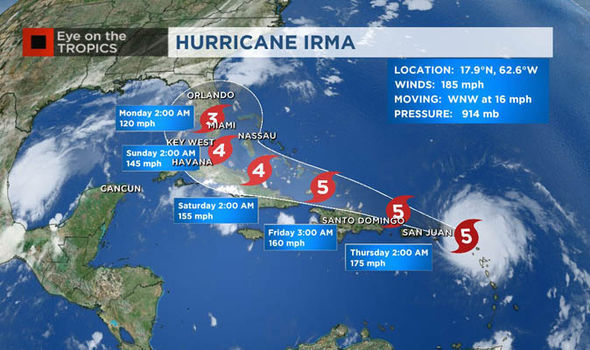Preparing for More Irmas: by Adaptation or Mitigation?
Staff Writers Zach Murdock and Elizabeth Djinis did a nice job in the Sarasota Herald Tribune (Preparing for More Irmas, 9/17/2017) explaining that hurricane Irma represents the new normal: the strongest storms should get stronger in the coming decades as the ocean temperatures warm; creeping sea level rise will make storm surges and inundation worse, particularly for low-lying areas; and storms that do form are likely to bring more precipitation with them.
Now that the likelihood of increasing catastrophic weather events is on people’s minds, taking action becomes more of a priority. As Tom Barwin, Sarasota City Manager said “Perhaps IRMA is the kick in the shins we needed to begin a more pro-active response to climate change in Florida… and around the world for that matter.”
What kind of action? There are two strategies for dealing with the climate change crisis: Adaptation and Mitigation. Examples of adaptation are building dikes and elevating buildings. These are the kinds of action the City Manager may have in mind for protecting the 220 Sarasota city assets identified as vulnerable to seal level rise.
Adaptation gets a lot of attention, in part because there is money to be made. National Geographic explains how some are profiting on the threat of rising seas. A proposal for floating islands in the Miami area is an example. “We will dredge to prop everything up,” one Miami land use attorney says. “The watchwords are protect, accommodate, and retreat, which sound a lot like a civil engineer’s version of the stages of grief”.1 While adaptation may be profitable for contractors, it is costly for consumers. Elevating a $300,000 home can cost well over $100,000.
Mitigation has to do with slowing and/or reversing global warming, and therefore reducing the likelihood of severe weather events and catastrophic sea level rise. Mitigation actions attempt to draw down the excess greenhouse gases in the atmosphere, which are the cause of climate change. Drawdown has two components: (1) eliminating the cause of the problem by reducing/eliminating emissions of greenhouse gases, and (2) increasing photosynthesis, the process by which plants remove carbon dioxide (the principle greenhouse gas) from the atmosphere and store it in the soil.
Unlike adaptation, which is costly, mitigation can provide a near term return on investment, if done right. For example, a family investing in a solar water heater can reduce a household’s emissions from electrical energy by as much as 30%. That investment can pay a handsome return of 25-30%.2 On a larger scale, the transition to zero emission energy will serve as an economic boost. Solar jobs in the United States have increased at least 20 percent per year for the past four years. The solar industry added $84 billion to the US GDP in 2016.3
A 2016 Goldman Sachs research paper says wind provides the lowest cost source of electricity (2.9 cents/kwh compared to 3.8 cents for fracked natural gas).4 Less carbon pollution saves lives as well as money. Stanford research estimates that converting to zero emission energy will eliminate about 65,000 premature deaths caused by air pollution in the United States each year, and save about $2,600/person/yr in health costs.5
John Darovec, a Bradenton biologist and group leader with Citizens’ Climate Lobby, says adaptation is trying to manage what you cannot avoid, and mitigation is trying to avoid what you cannot manage. Given the cost of the former and the benefits of the latter, it makes plenty of sense to focus on mitigation. Michael Oppenheimer, one of the co-author’s of the UN report on climate change says, “Everyone agrees that if we don’t slow the warming down, our prospects for adaptation are not good.”6
So how do we prepare for more Irmas? Adaptation, which aims to protect us from the problem, is necessary, and something we will need to pay for. Mitigation makes sense because it works to solve the problem and pays a return. We cannot afford not to mitigate… and the sooner we do, the better our chances for a stable climate and a livable world.
A Vietnam veteran, William “Coty” Keller is an ecologist and Florida Master Naturalist. He lives and works in Port Charlotte, FL. Current projects include leading the local chapter of Citizens’ Climate Lobby, eradicating invasive species from the mangroves in the Charlotte Harbor Aquatic Preserve, and promoting action on Climate Change with Florida Veterans for Common Sense. With co-author John Darovec, he wrote Urgency and Action: mitigating climate change, a guide to specific actions to slow and reverse global warming. 7
[1] Laura Parker, “Treading Water,” National Geographic February 2013 p107-125
[2] 40,000 lb. Carbon Diet: how a middle class American Family cut its carbon footprint by 75% and made money doing it. http://www.ecopapak.org/ecology/What%20to%20Do/40,000%20lb.%20carbon%20diet.pdf
[3] Solar Jobs Census https://www.thesolarfoundation.org/solar-jobs-census/
[4] Drawdown: The Most Comprehensive Plan Ever Proposed to Reverse Global Warming . Penguin Books, p. 2-4. See detailed references at http://www.drawdown.org/solutions/energy/wind-turbines-onshore and http://www.drawdown.org/solutions/energy/wind-turbines-offshore
[5] The Solutions Project. http://thesolutionsproject.org.
[6] Mufson, Steven. 2014. “U.N. climate panel: Governments, businesses need to take action now against growing risks.” Washington Post, March 30.
[7] Urgency and Action: mitigating climate change. 2017. Florida Veterans for Common Sense. http://www.ecopapak.org/ecology/What%20to%20Do/FLVCS%20Climate%20Change%20Report.pdf

